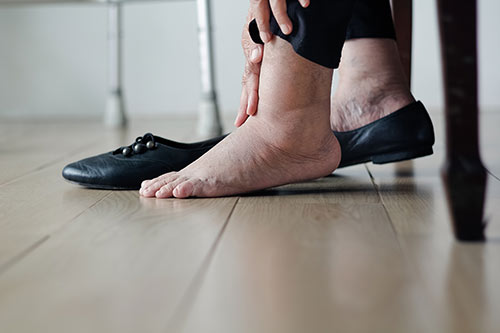Swollen ankles, feet and legs? That could be the reason.
Swelling in the legs caused by fluid accumulation often occurs in people who stand or sit for long periods of time. But what is behind it and what can be done about it? We explain the possible causes of swollen legs and under what circumstances it makes sense to see a doctor.
Anyone who spends the whole day standing or sitting will know the feeling: when you get home in the evening, you have to put your legs up because they are swollen. What is colloquially referred to as "puffy ankles or legs" is actually an accumulation of fluid in the tissue - also known as oedema. We will discuss several potential causes of oedema.
Thromboses and venous insufficiency

If the problem only occurs on one side, it may be caused by a venous thrombosis, i.e. a vein "blocked" by a blood clot that obstructs the flow of blood from the legs. Such a thrombosis is often caused by lack of exercise because sitting or standing for long periods of time means that the blood does not circulate sufficiently. However, thrombosis can also be caused by chronic venous insufficiency - in this case, the venous valves in the deep veins of the legs are too weak, which leads to blood backing up and increased pressure in the leg veins. Gravity forces the watery blood components out of the capillaries, the smaller blood vessels in the veins. This fluid then slowly accumulates outside the veins in the surrounding tissue. This can lead to a feeling of tightness or heaviness, overheated legs and even pain. Varicose veins can also develop due to the increased pressure in the veins.
In rare cases, venous thrombosis can have serious consequences. If you suspect acute venous thrombosis, you should therefore consult your doctor. He or she will decide whether an ultrasound examination should be carried out immediately or whether a blood test should be carried out first, the so-called D-dimer test
Non-draining lymphatic fluid
A blockage of the lymph vessels is also a possible cause of swollen legs. In this case, the removal of lymphatic fluid is impaired, which then accumulates in the tissue. There can be many causes for this. Lymphoedema is usually treated with lymphatic drainage (a special massage), compression therapy (bandages or stockings) and exercise therapy.
Kidney and liver problems
But what if not just one leg is affected, but both? There can also be several reasons for this. For example, if it is due to malnutrition or liver disease , for example, this can result in water retention throughout the body, as proteins have a water-binding function in the blood. If there is a protein deficiency, this function is impaired, the fluid in the blood is not sufficiently bound and can penetrate into the surrounding tissue. If the kidneys are weak, excess water can no longer be completely excreted via the urine and then accumulates in the tissue - mainly in the legs due to gravity.
Heart failure as a common cause of water in the legs
In heart failure, the heart pumps less blood through the body, or slower than a healthy heart does. The blood therefore builds up on the way to the heart, i.e. in the veins - and also in the leg veins. The increased pressure and the larger amount of fluid then also lead to the fluid accumulating in the surrounding tissue. The effect: the legs swell. The reduced pumping capacity of the heart leads to poorer blood flow to all organs, including the kidneys. Because the kidneys misinterpret this as low blood pressure, they try to increase the blood pressure again by excreting less water in the urine. As a result, the amount of excess fluid in the body increases even further. In the long term, this complex interplay can also lead to kidney failure in the case of existing heart failure, which places additional strain on the body.
Heart failure right or left?
Right and left heart failure have different symptoms. If the function of the right side of the heart is reduced, the main symptom is water retention. In contrast, reduced function of the left side of the heart is characterised by shortness of breath. However, if a backlog has formed in the left side of the heart, oedema can also occur in the lungs with left-sided heart failure.
Heart failure can also lead to fluid retention, particularly in the ankles and lower legs. As the fluid flows back more when lying down and the kidneys are better supplied with blood again, this can also lead to an increased urge to urinate at night. As with deep vein thrombosis, right heart failure can also lead to varicose veins, which develop due to the increased pressure in the leg veins. If you notice other symptoms in addition to swollen legs, such as rapid fatigue or shortness of breath, you should consult your doctor to clarify the cause.
If you already have heart failure, increasing leg swelling may be a sign that your current treatment needs to be adjusted as soon as possible. In order to detect water retention at an early stage and adjust your treatment accordingly, doctors often advise you to monitor your weight.
- References
- The 2022 All-Ireland Guidelines for the diagnosis, assessment and management of lymphoedema. www.lnni.org/content/2022-all-ireland-guidelines-diagnosis-assessment-and-management-lymphoedema.
- thrombosisuk.org/patient-information/
- Your guide to heart failure. www.bhf.org.uk/informationsupport/publications/heart-conditions/your-guide-to-heart-failure
- pumpingmarvellous.org
9-UK-5-16498-01 08-2025

